
Physical security describes security measures that are designed to deny unauthorized access to facilities, equipment, and resources and to protect personnel and property from damage or harm. Physical security involves the use of multiple layers of interdependent systems that can include CCTV surveillance, security guards, protective barriers, locks, access control, perimeter intrusion detection, deterrent systems, fire protection, and other systems designed to protect persons and property.

A metro station or subway station is a train station for a rapid transit system, which as a whole is usually called a "metro" or "subway". A station provides a means for passengers to purchase tickets, board trains, and evacuate the system in the case of an emergency. In the United Kingdom, they are known as underground stations, most commonly used in reference to the London Underground.
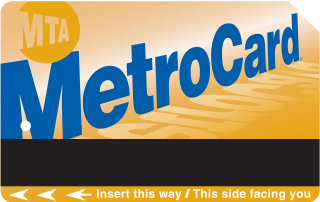
The MetroCard is a magnetic stripe card used for fare payment on transportation in the New York City area. It is a payment method for the New York City Subway, New York City Transit buses and MTA buses. The MetroCard is also accepted by several partner agencies: Nassau Inter-County Express (NICE), the PATH train system, the Roosevelt Island Tramway, AirTrain JFK, and Westchester County's Bee-Line Bus System.
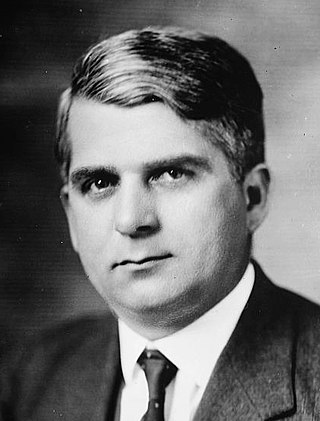
Clarence Saunders was an American grocer who first developed the modern retail sales model of self service. His ideas have had a massive influence on the development of the modern supermarket. Saunders worked for most of his life trying to develop a truly automated store, developing Piggly Wiggly, Keedoozle, and Foodelectric store concepts.
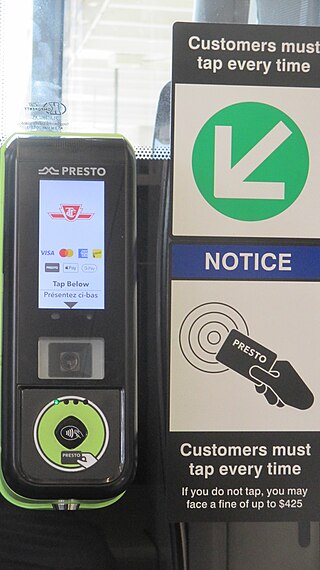
Fares to use the Toronto Transit Commission (TTC) transit system in Toronto, Ontario, Canada, can be paid with various media. The price of fares varies according to age, occupation, income level, and health condition of riders.
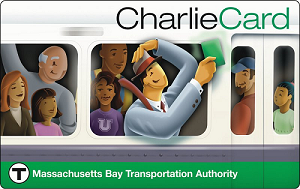
The CharlieCard is a contactless smart card used for fare payment for transportation in the Boston area. It is the primary payment method for the Massachusetts Bay Transportation Authority (MBTA) and several regional public transport systems in the U.S. state of Massachusetts.

Proof-of-payment(POP) or proof-of-fare(POF) is an honor-based fare collection system used on many public transportation systems. Instead of checking each passenger as they enter a fare control zone, passengers are required to carry a paper ticket, transit pass, transit smartcard - or open payment methods such as contactless credit or debit cards (if applicable) - after swiping or tapping on smart card readers, to prove that they have paid the valid fare. Fares are enforced via random spot-checks by inspectors such as conductors or enforcement officers, to ensure that passengers have paid their fares and are not committing fare evasion. On many systems, a passenger can purchase a single-use ticket or multi-use pass at any time in advance, but must insert the ticket or pass into a validation machine immediately before use. Validation machines in stations or on board vehicles time stamp the ticket. The ticket is then valid for some period of time after the stamped time.

One-way traffic is traffic that moves in a single direction. A one-way street is a street either facilitating only one-way traffic, or designed to direct vehicles to move in one direction. One-way streets typically result in higher traffic flow as drivers may avoid encountering oncoming traffic or turns through oncoming traffic. Residents may dislike one-way streets due to the circuitous route required to get to a specific destination, and the potential for higher speeds adversely affecting pedestrian safety. Some studies even challenge the original motivation for one-way streets, in that the circuitous routes negate the claimed higher speeds.

In numismatics, token coins or trade tokens are coin-like objects used instead of coins. The field of token coins is part of exonumia and token coins are token money. Their denomination is shown or implied by size, color or shape. They are often made of cheaper metals like copper, pewter, aluminium, brass and tin, or non-metals like bakelite, leather and porcelain.

A transfer allows the rider of a public transportation vehicle who pays for a single-trip fare to continue the trip on another bus or train. Depending on the network, there may or may not be an additional fee for the transfer. Historically, transfers may have been stamped or hole-punched with the time, date, and direction of travel to prevent their use for a return trip. More recently, magnetic or barcoded tickets may be recorded or ticket barriers may only charge on entry and exit to a larger system.

The Breeze Card is a stored value smart card that passengers use as part of an automated fare collection system which the Metropolitan Atlanta Rapid Transit Authority (MARTA) introduced to the general public in early October 2006. The card automatically debits the cost of the passenger’s ride when placed on or near the Breeze Target at the fare gate. Transit riders are able to add value or time-based passes to the card at Breeze Vending Machines (BVM) located at all MARTA stations. The major phases of MARTA's Breeze transformation took place before July 1, 2007 when customers were still able to purchase TransCards from ridestores or their employers. They were also able to obtain paper transfers from bus drivers to access the train. As of July 1, 2007 the TransCard and the paper transfers were discontinued and patrons now use a Breeze Card or ticket to access the system, and all transfers are loaded on the card. Breeze Vending Machines (BVM) distribute regional transit provider passes The Breeze Card employs passive RFID technology currently in use in many transit systems around the world.
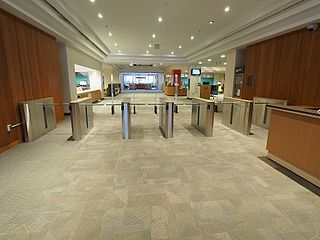
An optical turnstile is a physical security device designed to restrict or control access to a building or secure area. Optical turnstiles are usually a part of an access control system, which also consists of software, card readers, and controllers. Optical turnstiles operate much like regular mechanical turnstiles, except that they rely primarily on electronic (infrared) beams, and audible/visual interfaces to control entry. Rather than physically restraining a person, the optical turnstile uses sounds and lights to alert others to attempted entry by unauthorized individuals. The advent of the Americans with Disabilities Act (ADA) drove optical turnstile development because physical barriers for access were no longer legal for public access due to the fact that persons in wheelchairs or with other disabilities could not use them as access points. For this reason, they are not likely to be used in subways and stadiums, as they are suited for settings where design and aesthetics are deemed important, such as lobbies. These include high rise buildings with a single path through the lobby and staffed reception. The rate of people passing through the optical turnstile is high, with less delay than other methods. They are also suitable for the handicapped, as they are barrier-free.

The fares for services operated under the brands of MTA Regional Bus, New York City Subway, Staten Island Railway (SIR), PATH, Roosevelt Island Tramway, AirTrain JFK, NYC Ferry, and the suburban bus operators Nassau Inter-County Express (NICE) and Westchester County Bee-Line System (Bee-Line) are listed below. As of 2024, most bus routes, the subway, the Staten Island Railway, and the Roosevelt Island Tramway charge a $2.90 fare; a higher fare is charged for ferries, express buses, and the AirTrain JFK.

Airport check-in is the process whereby an airline approves airplane passengers to board an airplane for a flight. Airlines typically use service counters found at airports for this process, and the check-in is normally handled by an airline itself or a handling agent working on behalf of an airline. Passengers usually hand over any baggage that they do not wish or are not allowed to carry in the aircraft's cabin and receive a boarding pass before they can proceed to board their aircraft.
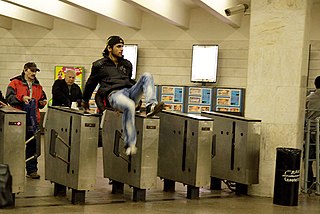
Fare evasion or fare dodging is the act of travel without payment on public transit. When considered problematic, it is mitigated by revenue protection officers and ticket barriers, staffed or automatic, are in place to ensure only those with valid tickets may access the transport. The term fare avoidance is sometimes used as a euphemistic synonym and sometimes used to refer to the lawful use of much cheaper tickets.

The OV-chipkaart is a contactless smart card and integrated ticketing system used for all public transport in the Netherlands. First introduced in the Rotterdam Metro in April 2005, it has subsequently been rolled out to other areas and travel modes. It fully replaced the national strippenkaart system for buses, trams, and metro trains in 2011, and the paper ticket system for rail travel in July 2014.
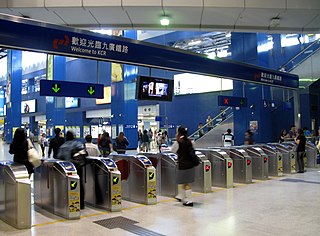
In rail transport, the paid area is a dedicated "inner" zone in a railway station or metro station, accessible via turnstiles or other barriers, to get into which, visitors or passengers require a valid ticket, checked smartcard or a pass. A system using paid areas is often called fare control. Passengers are allowed to enter or exit only through a faregate. A paid area usually exists in rapid transit railway stations for separating the train platform from the station exit, ensuring a passenger has paid or prepaid before reaching the railway platform and using any transport service. Such design requires a well-organized railway station layout. In some systems, paid areas are named differently - for example, on railways in the United Kingdom they are called compulsory ticket areas.
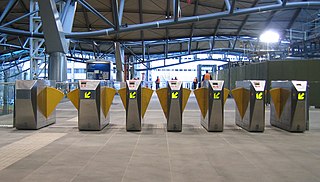
An automated fare collection (AFC) system is the collection of components that automate the ticketing system of a public transportation network – an automated version of manual fare collection. An AFC system is usually the basis for integrated ticketing.
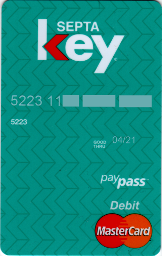
The SEPTA Key card is a smart card that is used for automated fare collection on the SEPTA public transportation network in the Philadelphia metropolitan area. It can be used throughout SEPTA's transit system, and on Regional Rail.
OMNY is a contactless fare payment system, currently being implemented for use on public transit in the New York metropolitan area. OMNY can currently be used to pay fares at all New York City Subway and Staten Island Railway stations, on all MTA buses, AirTrain JFK, Metro North's Hudson Rail Link, and on the Roosevelt Island Tram; when completely rolled out, it will also replace the MetroCard on Bee-Line buses, and NICE buses. OMNY will also expand beyond the current scope of the MetroCard to include the Long Island Rail Road and Metro-North Railroad.























